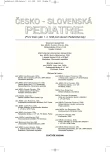Modern Management of Cystic Fibrosis and Its Influence upon General Health and Survival of Czech Patients
Authors:
D. Zemková 1; V. Skalická 1; J. Bartošová 1; L. Smolíková 2; J. Brázová 1; T. Fischerová 1; K. Böhmová 1; L. Pelikán 1; S. Koloušková 1; H. Chladová 1; P. Dřevínek 1; M. Macek ml. 3; P. Pohunek 1
Authors‘ workplace:
Pediatrická klinika UK 2. LF a FN Motol, Praha
přednosta prof. MUDr. J. Lebl, CSc.
1; Klinika rehabilitace UK 2. LF a FN Motol, Praha
přednosta doc. PaedDr. P. Kolář
2; Ústav biologie a lékařské genetiky UK 2. LF a FN Motol, Praha
přednosta prof. MUDr. M. Macek ml., DrSc.
3
Published in:
Čes-slov Pediat 2008; 63 (2): 76-82.
Overview
Cystic fibrosis is a severe multisystemic autosomal recessively inherited disease. The disease becomes manifest with repeating respiratory tract infections, failure to thrive, high concentrations of salt in the sweat, and other complications. Up to 98% of adult men suffering from cystic fibrosis are infertile.
Management of cystic fibrosis must be complex, systematic, and should be managed by an experienced team of specialists. The expensive treatment the authors describe wasn’t fully accessible to patients until the year 1989. Comparing the status of patients on different therapeutic regimes allows assessing the importance of modern treatment and its influence upon nutritional status, lung function, and patient survival.
A group of 639 patients diagnosed between 1960 and June 6, 2007 at the CF Centre of Faculty Hospital Motol, Prague, was divided into three cohorts according to year of birth. Cohort I comprised 187 patients born before the year 1975. In cohort II are included 165 patients born between January 1, 1976 and December 31, 1985. Cohort III consists of 287 patients born after January 1, 1986. Cohort III is further divided into two subgroups.
Authors compared semi-longitudinal anthropometric and spirometric data in each category using the t-test. The length of survival in each group was analysed using Kaplan-Mayer’s function of survival and the cohorts were compared using the Long Rank test.
High mortality rate, poor nutritional status, which especially worsened during puberty, and growth retardation were characteristic for the oldest cohort. Modern treatment methods applied in cohort II led to improvement of nutritional status, central airway obstruction, and increased median of survival from 16.3 to 25.3 years. Modern treatment from early childhood in cohort III led to improvement of peripheral airway obstruction and a higher age of survival. Intensive treatment from early childhood lowers mortality during childhood to a minimum.
Authors have proven that modern management of CF improves nutritional status, lung function, and age of survival.
Key words:
cystic fibrosis, complex management, longitudinal follow-up, survival, lung function, nutritional status
Sources
1. Vávrová V, a kol. Cystická fibróza. Praha: Grada, 2006. 520 s. ISBN 80-247-0531-1.
2. Houštěk J, Vávrová V. K výskytu cystické fibrózy pankreatu v ČSSR. Čs. Pediat. 1962;17 : 445–451.
3. Houštěk J, Vávrová V. Výskyt a klinické formy mukoviscidosy. Prakt. Lék. 1969;49 : 219–222.
4. Hodson ME, Geddes DM. Cystic Fibrosis. 2nd ed. London: Arnold 2000. ISBN 0-340-74208-9.
5. Bush A, et al. Cystic Fibrosis in the 21st Century. Basel, S. Karger AG, 2006. ISBN 3-8055-7960-8, ISSN 1422-2140.
6. Doering G, et al. Early intervention and prevention of lung disease in cystic fibrosis: a European consensus. Journal of Cystic Fibrosis 2004;3(2): 67–91.
7. Canton R, et al. Antimicrobial therapy for pulmonary pathogenic colonisation and infection by Pseudomonas aeruginosa in cystic fibrosis patients. Clinical Microbiology and Infection 2005;11(9): 690–703.
8. Sinaasappel M, et al. Nutrition in patients with cystic fibrosis: a European consensus. J. Cystic Fibrosis 2002;1(2): 51–75.
9. Kerem E, Conway S, Elborn S, et al. Standards of care for patients with cystic fibrosis: a European consensus. J. Cystic Fibrosis 2005;4(1): 7–26.
10. Döring G, et al. Antibiotic therapy against Pseudomonas aeruginosa in cystic fibrosis: a European consensus. European Respiratory Journal 2000;16(4): 749–767.
11. Moran A, et al. Diagnosis, screening and management of cystic fibrosis related diabetes mellitus: a consensus conference report. Diabetes Research and Clinical Practice 1999;45(1): 61–73.
12. Koloušková S, Zemková D, Bartošová J, et al. Vývoj porušené glukózové tolerance a diabetu u pacientů s cystickou fibrózou. Čes.-slov. Pediat. 2003;5 : 270–273.
13. Boyle MP. Update on maintaining bone health in cystic fibrosis. Current Opinion in Pulmonary Medicine 2006;12(6): 453–458.
14. Vávrová V. Diagnostika cystické fibrózy – potní test. Čes.-slov. Pediat. 2005;4 : 235–236.
15. Vávrová V, Macek M Jr. Současný stav diagnostiky cystické fibrózy. Čes.-slov. Pediat. 1999;5 : 220–226.
16. Rosenstein BJ, et al. The diagnosis of cystic fibrosis: a consensus statement. Cystic Fibrosis Foundation Consensus Panel. Journal of Pediatrics 1998;132(4): 589–595.
17. Corey M, McLaughlin FJ, Williams M, et al. A comparison of survival, growth and pulmonary function in patients with cystic fibrosis in Boston and Toronto. J. Clin. Epidemiol. 1988;41 : 583–591.
18. Vospělová J, Zapletalová J, Kolek A. Hypotonická dehydratace jako první příznak cystické fibrózy. Čes.-slov. Pediat. 2002;11 : 631–635.
19. Vávrová V, Zemková D, Skalická V, et al. Problémy v diagnostice cystické fibrózy – potřeba novorozeneckého screeningu. Čes.-slov. Pediat. 2006;12 : 703–709.
20. Holubová A, Balaščaková M, Skalická V, et al. Novorozenecký screening cystické fibrózy v České republice: závěry pilotní studie. Čes.-slov. Pediat. 2007;4 : 197–195.
Labels
Neonatology Paediatrics General practitioner for children and adolescentsArticle was published in
Czech-Slovak Pediatrics

2008 Issue 2
Most read in this issue
- Newborn Screening in the Czech Republic and in Europe
- Current Diagnostic Strategies and Overview of Preimplantation, Prenatal and Postnatal DNA Diagnostics of Cystic Fibrosis in the Czech Republic
- Associate Professor Věra Vávrová and History of Cystic Fibrosis
- Cystic Fibrosis Related Diabetes Mellitus: Diagnostics and Therapy
